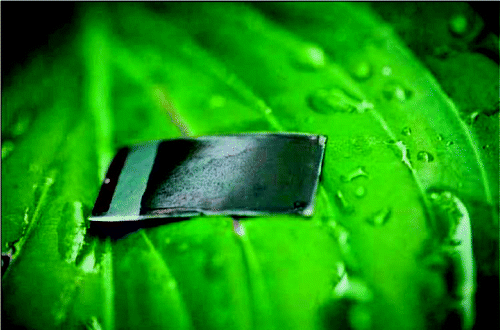A detailed description of development of the first practical artificial leaf — a milestone in the drive for sustainable energy that mimics the process, photosynthesis, that green plants use to convert water and sunlight into energy — appears in the ACS journal Accounts of Chemical Research. The article notes that unlike earlier devices, which used costly ingredients, the new device is made from inexpensive materials and employs low-cost engineering and manufacturing processes.
Daniel G. Nocera points out that the artificial leaf responds to the vision of a famous Italian chemist who, in 1912, predicted that scientists one day would uncover the "guarded secret of plants." The most important of those, Nocera says, is the process that splits water into hydrogen and oxygen. The artificial leaf has a sunlight collector sandwiched between two films that generate oxygen and hydrogen gas. When dropped into a jar of water in the sunlight, it bubbles away, releasing hydrogen that can be used in fuel cells to make electricity. These self-contained units are attractive for making fuel for electricity in remote places and the developing world, but designs demonstrated thus far rely on metals like platinum and manufacturing processes that make them cost-prohibitive.
To make these devices more widely available, Nocera replaced the platinum catalyst that produces hydrogen gas with a less-expensive nickel-molybdenum-zinc compound. On the other side of the leaf, a cobalt film generates oxygen gas. Nocera notes that all of these materials are abundant on Earth, unlike the rare and expensive platinum, noble metal oxides and semiconducting materials others have used. "Considering that it is the 6 billion nonlegacy users that are driving the enormous increase in energy demand by midcentury, a research target of delivering solar energy to the poor with discoveries such as the artificial leaf provides global society its most direct path to a sustainable energy future," he says.
More information: The Artificial Leaf, Acc. Chem. Res., Article ASAP. DOI: 10.1021/ar2003013
Abstract
To convert the energy of sunlight into chemical energy, the leaf splits water via the photosynthetic process to produce molecular oxygen and hydrogen, which is in a form of separated protons and electrons. The primary steps of natural photosynthesis involve the absorption of sunlight and its conversion into spatially separated electron–hole pairs. The holes of this wireless current are captured by the oxygen evolving complex (OEC) of photosystem II (PSII) to oxidize water to oxygen. The electrons and protons produced as a byproduct of the OEC reaction are captured by ferrodoxin of photosystem I. With the aid of ferrodoxin–NADP+ reductase, they are used to produce hydrogen in the form of NADPH. For a synthetic material to realize the solar energy conversion function of the leaf, the light-absorbing material must capture a solar photon to generate a wireless current that is harnessed by catalysts, which drive the four electron/hole fuel-forming water-splitting reaction under benign conditions and under 1 sun (100 mW/cm2) illumination.
Provided by American Chemical Society






















